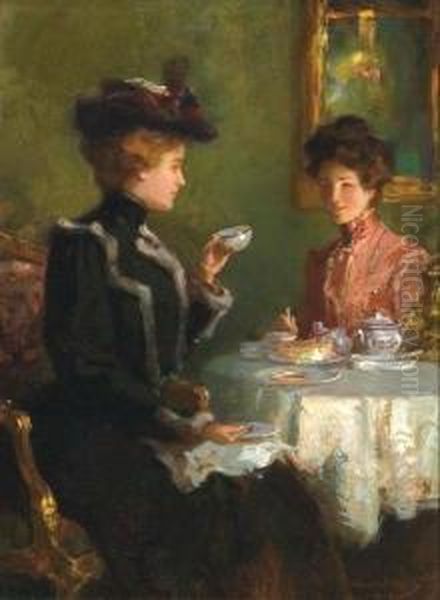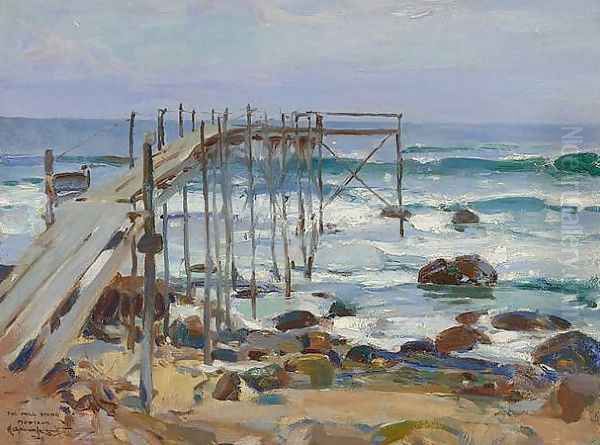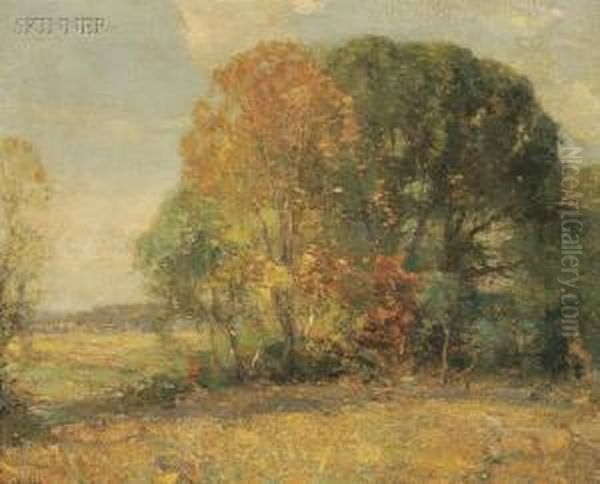Walter Granville-Smith (1870-1938) stands as a notable figure in American art history, recognized both for his pioneering work in color magazine illustration and his accomplished paintings in oil and watercolor. His career spanned a vibrant period of artistic development in the United States, witnessing the flourishing of the "Golden Age of Illustration" and the widespread adoption of Impressionist aesthetics. Granville-Smith navigated these currents with skill, leaving behind a legacy of charming, evocative imagery that captured the spirit of his time.
Early Life and Artistic Awakening
Born on January 28, 1870, in the aptly named town of Granville, Washington County, New York, Walter Granville-Smith's early life set the stage for a career immersed in the visual arts. His family later relocated to Newark, New Jersey, a move that proved pivotal for his artistic development. It was in Newark that he began his formal art education, laying the foundational skills that would serve him throughout his multifaceted career. The burgeoning industrial and cultural environment of the East Coast provided a stimulating backdrop for a young, aspiring artist.
Driven by ambition and a clear talent, Granville-Smith eventually made his way to New York City, the undisputed center of the American art world. There, he sought out instruction from established artists and institutions. He is known to have studied with figures such as Dr. David McCullouch, and significantly, he enrolled at the prestigious Art Students League of New York. The League was a crucible for artistic talent, offering a liberal environment where students could learn from a diverse faculty of prominent painters, including artists like William Merritt Chase, Kenyon Cox, and J. Alden Weir, who were shaping American art. His time at the League and under various tutors exposed him to different techniques and artistic philosophies, broadening his horizons and refining his craft.
A Pioneer in Color Illustration

While Granville-Smith would become a respected painter, his initial and perhaps most groundbreaking impact was in the field of illustration. The late 19th and early 20th centuries marked the "Golden Age of American Illustration," a period when magazines and books became lavishly illustrated, thanks in part to advancements in printing technology. Artists like Howard Pyle, N.C. Wyeth, and Maxfield Parrish were creating iconic images that reached vast audiences. Granville-Smith carved out a unique niche in this competitive field by becoming a pioneer in color illustration.
He holds the distinction of being the first American artist to have a machine-produced color illustration published in a magazine. This landmark work, titled "The Witch Christmas," appeared in Godey's Magazine in 1893. This was a significant technical and artistic achievement, as color printing was still a relatively new and complex process. His ability to adapt his artistic skills to the demands of this new technology set him apart and opened doors to numerous commissions. His illustrations subsequently graced the pages of many leading periodicals of the day, including Harper's Magazine, Scribner's Magazine, The Century Magazine, and Collier's Weekly. These publications were highly influential, shaping popular taste and providing a crucial platform for artists.
Granville-Smith's success as an illustrator demonstrated his versatility and his keen understanding of narrative and composition. His works often depicted scenes of contemporary life, romantic interludes, and charming vignettes, rendered with an appealing clarity and sensitivity to color that the new printing methods could reproduce. He contributed significantly to the visual culture of the era, making art accessible to a wide public through these popular magazines.
The Painter's Craft: Oils and Watercolors
Beyond his celebrated work as an illustrator, Walter Granville-Smith was a dedicated and prolific painter. He worked proficiently in both oil and watercolor, demonstrating a command of different mediums and exploring a range of stylistic approaches. His painterly output often reflected the prevailing artistic trends of his time, most notably American Impressionism, though his work also occasionally hinted at Symbolist undertones.
His landscapes, often depicting the serene countryside of the American Northeast or coastal scenes, show a sensitivity to light and atmosphere characteristic of Impressionism. Artists like Childe Hassam, John Henry Twachtman, and J. Alden Weir had popularized this style in America, adapting French Impressionist principles to the American environment. Granville-Smith's paintings in this vein often feature broken brushwork, a brightened palette, and an emphasis on capturing the fleeting moments of natural light. Scenes of leisurely garden parties, figures strolling by the water, or tranquil rural vistas were common subjects, reflecting an idyllic view of American life.

He was also an active member of the American Watercolor Society, indicating his commitment to this often-demanding medium. Watercolor allowed for a spontaneity and luminosity that complemented his Impressionistic leanings. His skill in handling transparent washes and his ability to capture the subtle nuances of color and light were evident in these works. His subjects in watercolor often mirrored those in his oils, focusing on landscapes, marine views, and genre scenes.
Notable Works and Artistic Style
Several specific works highlight Granville-Smith's artistic achievements and stylistic tendencies. "Summer Night," an oil painting measuring 36 x 44 1/4 inches, is one of his well-regarded pieces. While details of its specific subject matter are not extensively documented in all sources, the title itself evokes the Impressionist interest in capturing specific times of day and their atmospheric effects, a theme explored by artists like James McNeill Whistler in his "Nocturnes." Such a work likely showcased his ability to handle subtle gradations of color and light to create a particular mood.
"A Cup of Tea," completed in 1904, suggests a genre scene, perhaps depicting an elegant interior or a quiet moment of domesticity. This type of subject was popular among Impressionist painters, including Mary Cassatt and Edmund Tarbell, who often portrayed women in everyday settings. Granville-Smith's treatment would likely have combined graceful figural work with attention to the interplay of light and texture.
Other known titles, such as "The Boat Landing" (1915) and "The Mill," point to his interest in picturesque landscapes and scenes of rural or waterside life. These subjects provided ample opportunity to explore the effects of light on water, foliage, and architecture. "Two Ladies Skating in Central Park" is another evocative title, suggesting a lively urban scene capturing the fashionable leisure activities of New Yorkers, a subject also favored by contemporaries like William Glackens, a member of the Ashcan School who also depicted vibrant city life, albeit often with a grittier realism than typically found in Granville-Smith's more Impressionistic works.
His style, while often rooted in Impressionism, was not rigidly confined. The mention of "Symbolism" suggests that some of his works may have aimed for a more evocative, poetic, or allegorical quality, perhaps through the use of specific motifs or a more subjective approach to color and form. Artists like Albert Pinkham Ryder or Elihu Vedder represented a more pronounced Symbolist trend in American art, and Granville-Smith might have incorporated such elements subtly into his compositions.
Recognition, Affiliations, and the Art Community

Walter Granville-Smith was an active and respected member of the New York art community. His talents did not go unrecognized by his peers or by the leading art institutions of his day. He achieved the significant honor of being elected an Academician (NA) of the National Academy of Design, a prestigious body that included many of the nation's foremost artists. This recognition signified his high standing within the profession.
He was also deeply involved with the Salmagundi Club, one of New York's oldest and most venerable art clubs. The Salmagundi Club served as an important meeting place for artists, writers, and patrons, hosting exhibitions and fostering a collegial atmosphere. Granville-Smith's commitment to the club was evident in his service as its president from 1924 to 1926. His leadership role underscores his respected position among his fellow artists. It was noted that his works exhibited at the Salmagundi Club were often considered particularly outstanding.
Throughout his career, Granville-Smith received numerous awards for his paintings from institutions such as the National Academy of Design, the National Arts Club, and the Salmagundi Club itself. These accolades further cemented his reputation as a skilled painter. His participation in juried exhibitions and competitions placed him in dialogue and sometimes friendly rivalry with other prominent artists of the period, such as Frank Weston Benson, Edmund Tarbell, and Robert Reid, who were also garnering awards for their Impressionist works.
Contemporaries and the Artistic Milieu
Walter Granville-Smith's career unfolded within a rich and dynamic artistic environment. As an illustrator, he was part of the "Golden Age" that included luminaries whose work defined the era. Howard Pyle was a towering figure, not only for his own illustrations but also as an influential teacher whose students included N.C. Wyeth, Jessie Willcox Smith, and Maxfield Parrish. Charles Dana Gibson, creator of the iconic "Gibson Girl," set standards for social illustration, while J.C. Leyendecker was known for his sophisticated and stylish magazine covers. Frederic Remington captured the imagery of the American West, and Edwin Austin Abbey was renowned for his historical illustrations. Granville-Smith's pioneering work in color placed him at the forefront of technological adoption within this talented group.
As a painter, particularly one inclined towards Impressionism, he was contemporary with the leading figures of American Impressionism. Childe Hassam was perhaps the most famous American Impressionist, known for his vibrant cityscapes and New England scenes. William Merritt Chase was an influential teacher and a versatile painter whose Impressionist works were highly regarded. John Henry Twachtman developed a more Tonalist and abstract form of Impressionism, while J. Alden Weir's work was characterized by its poetic sensitivity. Theodore Robinson was one of the first American artists to fully embrace Impressionism, having worked closely with Claude Monet in Giverny. The Boston School, including painters like Frank Weston Benson and Edmund Tarbell, developed a distinctive regional variant of Impressionism, often focusing on elegant figures in sunlit interiors and exteriors. Willard Metcalf was another key member of "The Ten American Painters," a group that seceded from the Society of American Artists to exhibit their Impressionist works. Robert Vonnoh was also an early adopter of Impressionist techniques. Granville-Smith's landscape and genre paintings resonated with the aesthetic concerns of these artists.
His teachers, such as Walter Satterlee and James Carroll Beckwith (both prominent figures at the Art Students League), would have provided him with a solid academic grounding, even as he explored more modern styles. The art world of New York was a close-knit community, and artists often knew each other through institutions like the Art Students League, the National Academy of Design, and clubs like the Salmagundi.
Personal Life and Later Years
Walter Granville-Smith's personal life, while not as extensively documented as his professional career, included his marriage to Jessie. The couple had three children: two sons and a daughter. Family life often provided a quiet backdrop to the demanding career of an artist, and it's plausible that domestic scenes or portraits of family members may have occasionally featured in his work, as was common for many artists of his generation.
He continued to paint and exhibit throughout his life, maintaining his presence in the American art scene. His dedication to his craft remained steadfast even as artistic tastes began to shift with the advent of Modernism in the early 20th century. While some critics might have later categorized his Impressionistic style as more conservative—the provided information notes a comment labeling him a "third-rate East Coast Impressionist"—such evaluations often reflect changing fashions rather than a definitive judgment on an artist's skill or contemporary significance. His consistent record of awards and his esteemed positions within art organizations suggest that he was highly regarded by his peers during his lifetime.
Walter Granville-Smith passed away on December 7, 1938, in Queens, New York, at the age of 68. He left behind a substantial body of work that captured the charm and elegance of a bygone era.
Legacy and Collections
The legacy of Walter Granville-Smith is twofold. He is remembered as an important innovator in the history of American illustration, his early adoption of color printing techniques paving the way for future developments in magazine and book art. His contributions helped to elevate the status of illustration and brought vibrant, colorful imagery to a mass audience.
As a painter, his work is representative of the American Impressionist movement, showcasing a skilled handling of light, color, and atmosphere. His paintings offer a pleasing window into the leisurely pursuits and picturesque landscapes of early 20th-century America. While perhaps not as revolutionary as some of his avant-garde contemporaries, his art possessed a consistent quality and appeal that earned him respect and recognition.
Today, Walter Granville-Smith's works are held in the collections of several notable museums and art institutions, including the prestigious Smithsonian American Art Museum in Washington, D.C., and the Butler Institute of American Art in Youngstown, Ohio, which is dedicated to American art. The presence of his work in these collections ensures its preservation and continued accessibility for study and appreciation by future generations. His paintings also appear in private collections and occasionally surface at art auctions, where they continue to be valued for their aesthetic qualities and historical significance.
Conclusion
Walter Granville-Smith was an artist who successfully bridged the worlds of commercial illustration and fine art painting. His pioneering efforts in color illustration marked a significant moment in publishing history, while his paintings in oil and watercolor demonstrated his adeptness within the Impressionist tradition. Through his active participation in art societies, his leadership roles, and his consistent output of quality work, he made a tangible contribution to the American art scene of his time. His art provides a delightful visual record of the era, characterized by its charm, technical skill, and gentle optimism, securing his place as a noteworthy figure in the narrative of American art.